Analysis of a Business Problem: High Employee Turnover at Coffee Bean and Leaf
VerifiedAdded on 2023/06/07
|13
|3617
|324
AI Summary
This essay analyzes the problem of high employee turnover at Coffee Bean and Leaf, a coffee shop in Sydney, Australia. It describes the problem, analyzes it in detail, and provides an overview of the research designs that can be utilized in order to uncover solutions to the problem.
Contribute Materials
Your contribution can guide someone’s learning journey. Share your
documents today.
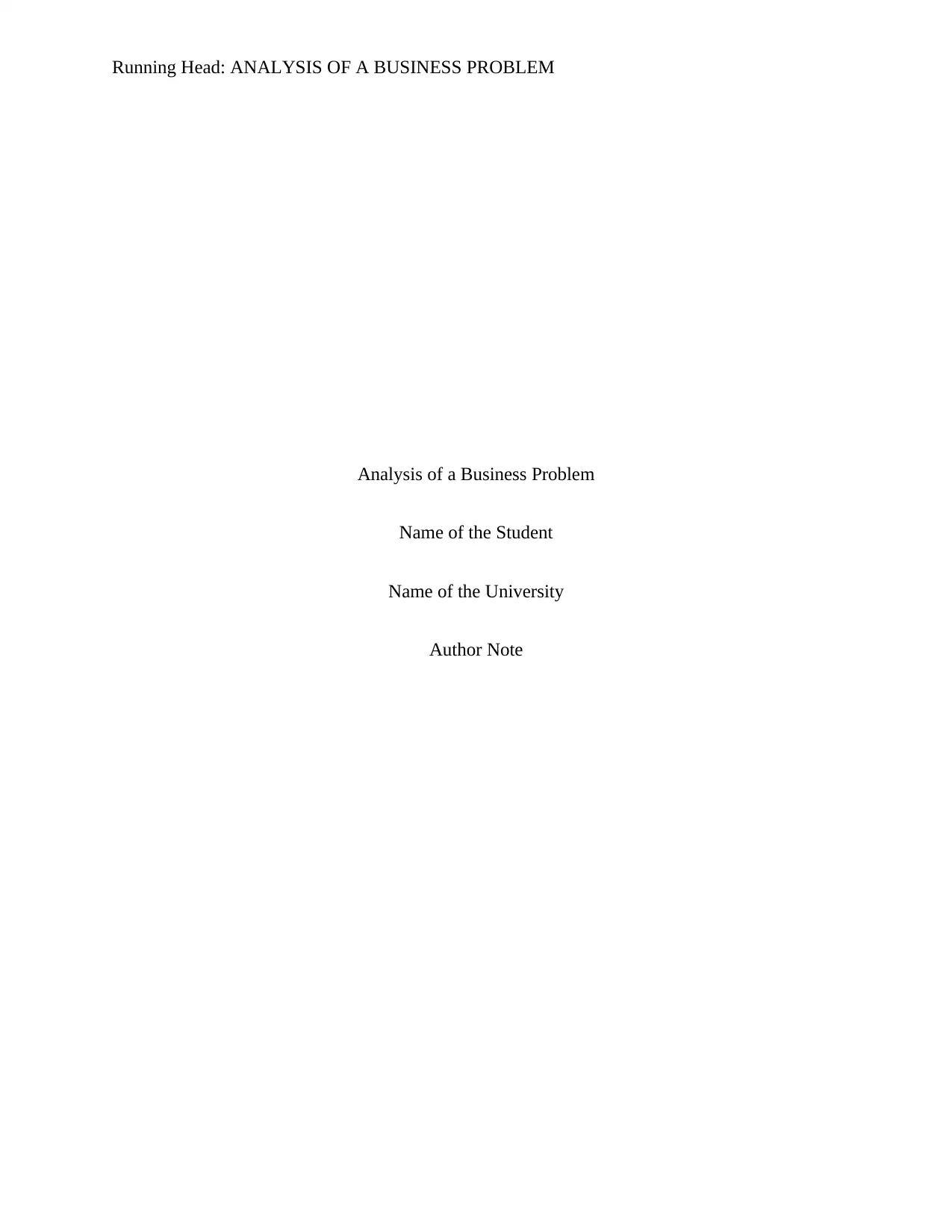
Running Head: ANALYSIS OF A BUSINESS PROBLEM
Analysis of a Business Problem
Name of the Student
Name of the University
Author Note
Analysis of a Business Problem
Name of the Student
Name of the University
Author Note
Secure Best Marks with AI Grader
Need help grading? Try our AI Grader for instant feedback on your assignments.
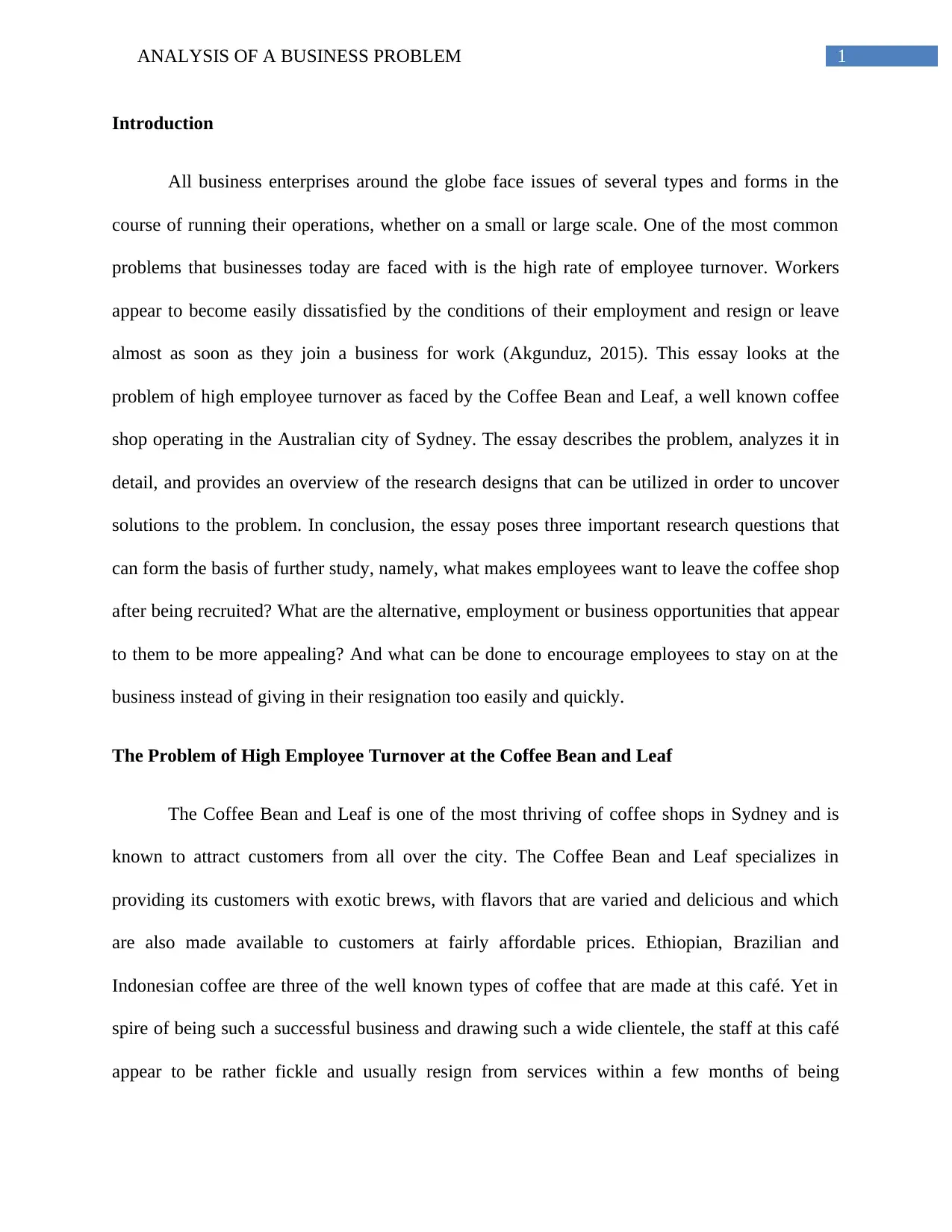
1ANALYSIS OF A BUSINESS PROBLEM
Introduction
All business enterprises around the globe face issues of several types and forms in the
course of running their operations, whether on a small or large scale. One of the most common
problems that businesses today are faced with is the high rate of employee turnover. Workers
appear to become easily dissatisfied by the conditions of their employment and resign or leave
almost as soon as they join a business for work (Akgunduz, 2015). This essay looks at the
problem of high employee turnover as faced by the Coffee Bean and Leaf, a well known coffee
shop operating in the Australian city of Sydney. The essay describes the problem, analyzes it in
detail, and provides an overview of the research designs that can be utilized in order to uncover
solutions to the problem. In conclusion, the essay poses three important research questions that
can form the basis of further study, namely, what makes employees want to leave the coffee shop
after being recruited? What are the alternative, employment or business opportunities that appear
to them to be more appealing? And what can be done to encourage employees to stay on at the
business instead of giving in their resignation too easily and quickly.
The Problem of High Employee Turnover at the Coffee Bean and Leaf
The Coffee Bean and Leaf is one of the most thriving of coffee shops in Sydney and is
known to attract customers from all over the city. The Coffee Bean and Leaf specializes in
providing its customers with exotic brews, with flavors that are varied and delicious and which
are also made available to customers at fairly affordable prices. Ethiopian, Brazilian and
Indonesian coffee are three of the well known types of coffee that are made at this café. Yet in
spire of being such a successful business and drawing such a wide clientele, the staff at this café
appear to be rather fickle and usually resign from services within a few months of being
Introduction
All business enterprises around the globe face issues of several types and forms in the
course of running their operations, whether on a small or large scale. One of the most common
problems that businesses today are faced with is the high rate of employee turnover. Workers
appear to become easily dissatisfied by the conditions of their employment and resign or leave
almost as soon as they join a business for work (Akgunduz, 2015). This essay looks at the
problem of high employee turnover as faced by the Coffee Bean and Leaf, a well known coffee
shop operating in the Australian city of Sydney. The essay describes the problem, analyzes it in
detail, and provides an overview of the research designs that can be utilized in order to uncover
solutions to the problem. In conclusion, the essay poses three important research questions that
can form the basis of further study, namely, what makes employees want to leave the coffee shop
after being recruited? What are the alternative, employment or business opportunities that appear
to them to be more appealing? And what can be done to encourage employees to stay on at the
business instead of giving in their resignation too easily and quickly.
The Problem of High Employee Turnover at the Coffee Bean and Leaf
The Coffee Bean and Leaf is one of the most thriving of coffee shops in Sydney and is
known to attract customers from all over the city. The Coffee Bean and Leaf specializes in
providing its customers with exotic brews, with flavors that are varied and delicious and which
are also made available to customers at fairly affordable prices. Ethiopian, Brazilian and
Indonesian coffee are three of the well known types of coffee that are made at this café. Yet in
spire of being such a successful business and drawing such a wide clientele, the staff at this café
appear to be rather fickle and usually resign from services within a few months of being
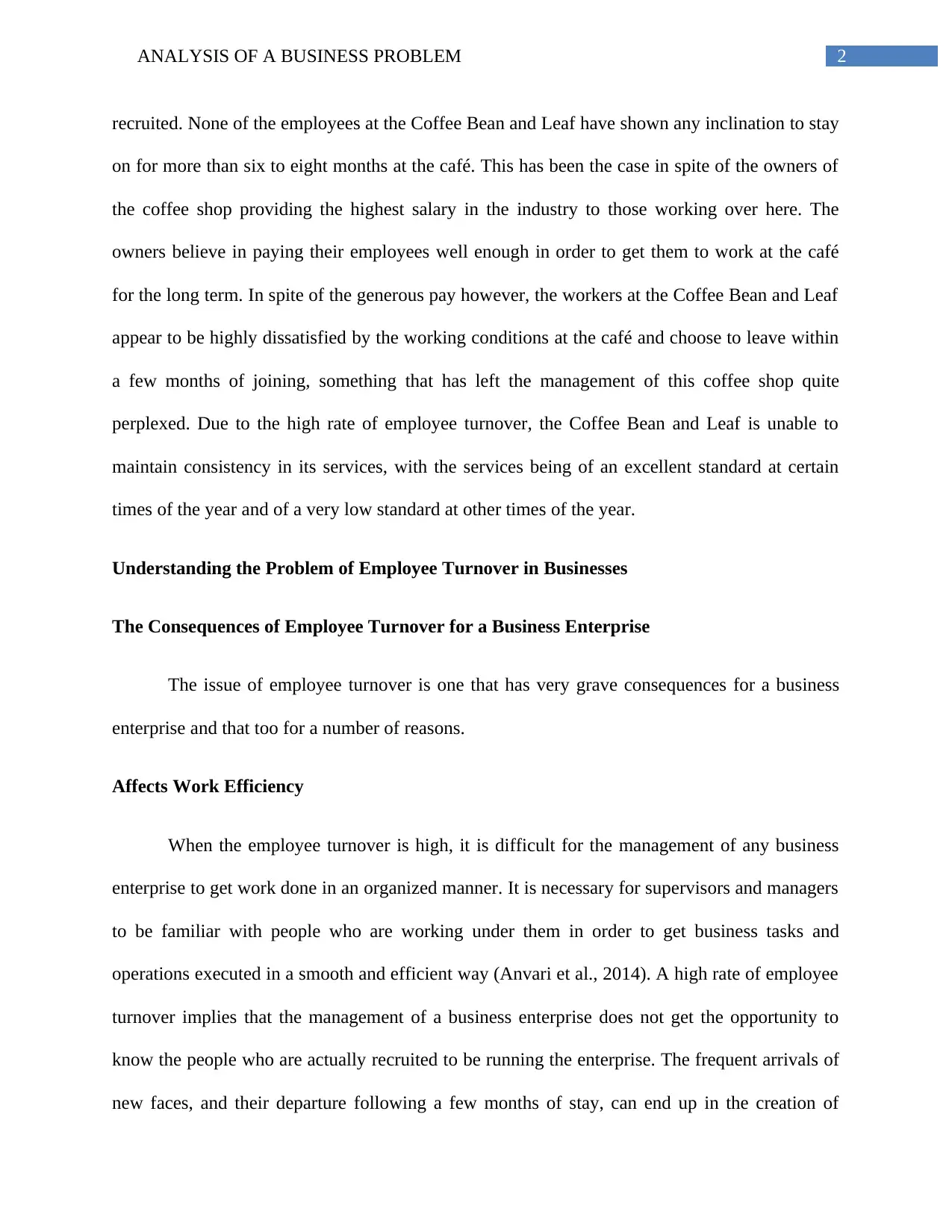
2ANALYSIS OF A BUSINESS PROBLEM
recruited. None of the employees at the Coffee Bean and Leaf have shown any inclination to stay
on for more than six to eight months at the café. This has been the case in spite of the owners of
the coffee shop providing the highest salary in the industry to those working over here. The
owners believe in paying their employees well enough in order to get them to work at the café
for the long term. In spite of the generous pay however, the workers at the Coffee Bean and Leaf
appear to be highly dissatisfied by the working conditions at the café and choose to leave within
a few months of joining, something that has left the management of this coffee shop quite
perplexed. Due to the high rate of employee turnover, the Coffee Bean and Leaf is unable to
maintain consistency in its services, with the services being of an excellent standard at certain
times of the year and of a very low standard at other times of the year.
Understanding the Problem of Employee Turnover in Businesses
The Consequences of Employee Turnover for a Business Enterprise
The issue of employee turnover is one that has very grave consequences for a business
enterprise and that too for a number of reasons.
Affects Work Efficiency
When the employee turnover is high, it is difficult for the management of any business
enterprise to get work done in an organized manner. It is necessary for supervisors and managers
to be familiar with people who are working under them in order to get business tasks and
operations executed in a smooth and efficient way (Anvari et al., 2014). A high rate of employee
turnover implies that the management of a business enterprise does not get the opportunity to
know the people who are actually recruited to be running the enterprise. The frequent arrivals of
new faces, and their departure following a few months of stay, can end up in the creation of
recruited. None of the employees at the Coffee Bean and Leaf have shown any inclination to stay
on for more than six to eight months at the café. This has been the case in spite of the owners of
the coffee shop providing the highest salary in the industry to those working over here. The
owners believe in paying their employees well enough in order to get them to work at the café
for the long term. In spite of the generous pay however, the workers at the Coffee Bean and Leaf
appear to be highly dissatisfied by the working conditions at the café and choose to leave within
a few months of joining, something that has left the management of this coffee shop quite
perplexed. Due to the high rate of employee turnover, the Coffee Bean and Leaf is unable to
maintain consistency in its services, with the services being of an excellent standard at certain
times of the year and of a very low standard at other times of the year.
Understanding the Problem of Employee Turnover in Businesses
The Consequences of Employee Turnover for a Business Enterprise
The issue of employee turnover is one that has very grave consequences for a business
enterprise and that too for a number of reasons.
Affects Work Efficiency
When the employee turnover is high, it is difficult for the management of any business
enterprise to get work done in an organized manner. It is necessary for supervisors and managers
to be familiar with people who are working under them in order to get business tasks and
operations executed in a smooth and efficient way (Anvari et al., 2014). A high rate of employee
turnover implies that the management of a business enterprise does not get the opportunity to
know the people who are actually recruited to be running the enterprise. The frequent arrivals of
new faces, and their departure following a few months of stay, can end up in the creation of
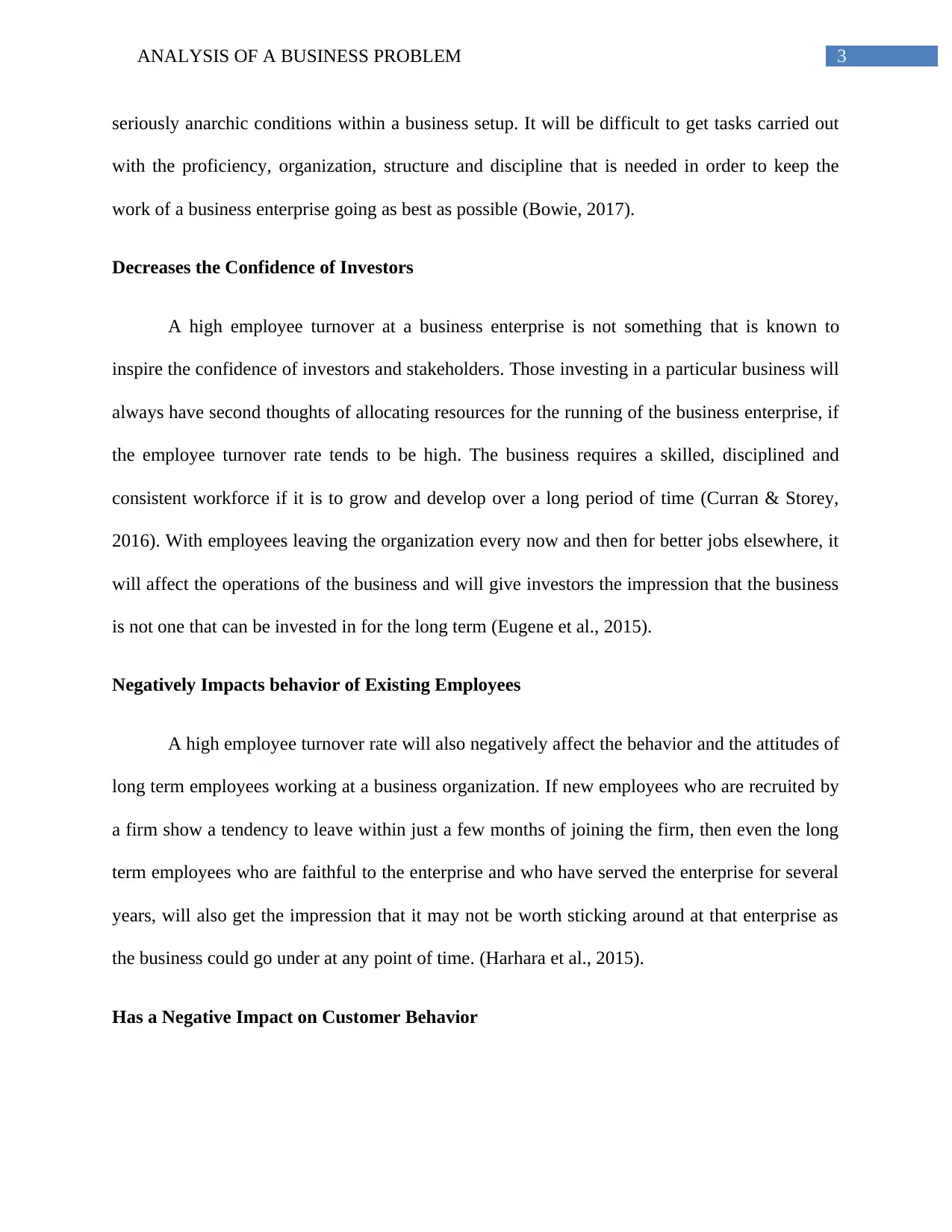
3ANALYSIS OF A BUSINESS PROBLEM
seriously anarchic conditions within a business setup. It will be difficult to get tasks carried out
with the proficiency, organization, structure and discipline that is needed in order to keep the
work of a business enterprise going as best as possible (Bowie, 2017).
Decreases the Confidence of Investors
A high employee turnover at a business enterprise is not something that is known to
inspire the confidence of investors and stakeholders. Those investing in a particular business will
always have second thoughts of allocating resources for the running of the business enterprise, if
the employee turnover rate tends to be high. The business requires a skilled, disciplined and
consistent workforce if it is to grow and develop over a long period of time (Curran & Storey,
2016). With employees leaving the organization every now and then for better jobs elsewhere, it
will affect the operations of the business and will give investors the impression that the business
is not one that can be invested in for the long term (Eugene et al., 2015).
Negatively Impacts behavior of Existing Employees
A high employee turnover rate will also negatively affect the behavior and the attitudes of
long term employees working at a business organization. If new employees who are recruited by
a firm show a tendency to leave within just a few months of joining the firm, then even the long
term employees who are faithful to the enterprise and who have served the enterprise for several
years, will also get the impression that it may not be worth sticking around at that enterprise as
the business could go under at any point of time. (Harhara et al., 2015).
Has a Negative Impact on Customer Behavior
seriously anarchic conditions within a business setup. It will be difficult to get tasks carried out
with the proficiency, organization, structure and discipline that is needed in order to keep the
work of a business enterprise going as best as possible (Bowie, 2017).
Decreases the Confidence of Investors
A high employee turnover at a business enterprise is not something that is known to
inspire the confidence of investors and stakeholders. Those investing in a particular business will
always have second thoughts of allocating resources for the running of the business enterprise, if
the employee turnover rate tends to be high. The business requires a skilled, disciplined and
consistent workforce if it is to grow and develop over a long period of time (Curran & Storey,
2016). With employees leaving the organization every now and then for better jobs elsewhere, it
will affect the operations of the business and will give investors the impression that the business
is not one that can be invested in for the long term (Eugene et al., 2015).
Negatively Impacts behavior of Existing Employees
A high employee turnover rate will also negatively affect the behavior and the attitudes of
long term employees working at a business organization. If new employees who are recruited by
a firm show a tendency to leave within just a few months of joining the firm, then even the long
term employees who are faithful to the enterprise and who have served the enterprise for several
years, will also get the impression that it may not be worth sticking around at that enterprise as
the business could go under at any point of time. (Harhara et al., 2015).
Has a Negative Impact on Customer Behavior
Secure Best Marks with AI Grader
Need help grading? Try our AI Grader for instant feedback on your assignments.

4ANALYSIS OF A BUSINESS PROBLEM
The high employee turnover is something that can definitely have a negative impact on
the behavior of customers or clients. If clients have been frequenting a coffee shop for instance,
and soon find out after awhile, that whoever joins the team of staff members at this coffee shop,
leaves within a few months of joining, then they will become skeptical about the quality of the
services that are offered at the coffee shop and will want instead to frequent a joint that shows
more consistency in this respect (Hom et al., 2017).
Causes of High Employee Turnover in a Business
The causes of high employee turnover for a business enterprise tend to be quite varied in
nature, and must be urgently addressed or looked into, if the problem of employee turnover is to
be well managed and controlled.
Inadequate Pay
One of the most important causes of high employee turnover is poor pay. If workers are
not happy with the amount of remuneration that they are getting for the work that they do, then
they will be likely to leave that enterprise immediately and look for a better job elsewhere
(Huffman et al., 2014).
Unsuitable Work Conditions
Another important reason behind the high employee turnover for a business enterprise is
unsuitable working conditions. The ambience at the work place is one that needs to be conducive
for productivity. If the work environment is unhealthy, in the sense that there is great degree of
hostility and workers are fighting with each other for the most part, or are fighting with those
who supervise them, then they will not feel inclined to be as productive as they can be. It is only
The high employee turnover is something that can definitely have a negative impact on
the behavior of customers or clients. If clients have been frequenting a coffee shop for instance,
and soon find out after awhile, that whoever joins the team of staff members at this coffee shop,
leaves within a few months of joining, then they will become skeptical about the quality of the
services that are offered at the coffee shop and will want instead to frequent a joint that shows
more consistency in this respect (Hom et al., 2017).
Causes of High Employee Turnover in a Business
The causes of high employee turnover for a business enterprise tend to be quite varied in
nature, and must be urgently addressed or looked into, if the problem of employee turnover is to
be well managed and controlled.
Inadequate Pay
One of the most important causes of high employee turnover is poor pay. If workers are
not happy with the amount of remuneration that they are getting for the work that they do, then
they will be likely to leave that enterprise immediately and look for a better job elsewhere
(Huffman et al., 2014).
Unsuitable Work Conditions
Another important reason behind the high employee turnover for a business enterprise is
unsuitable working conditions. The ambience at the work place is one that needs to be conducive
for productivity. If the work environment is unhealthy, in the sense that there is great degree of
hostility and workers are fighting with each other for the most part, or are fighting with those
who supervise them, then they will not feel inclined to be as productive as they can be. It is only
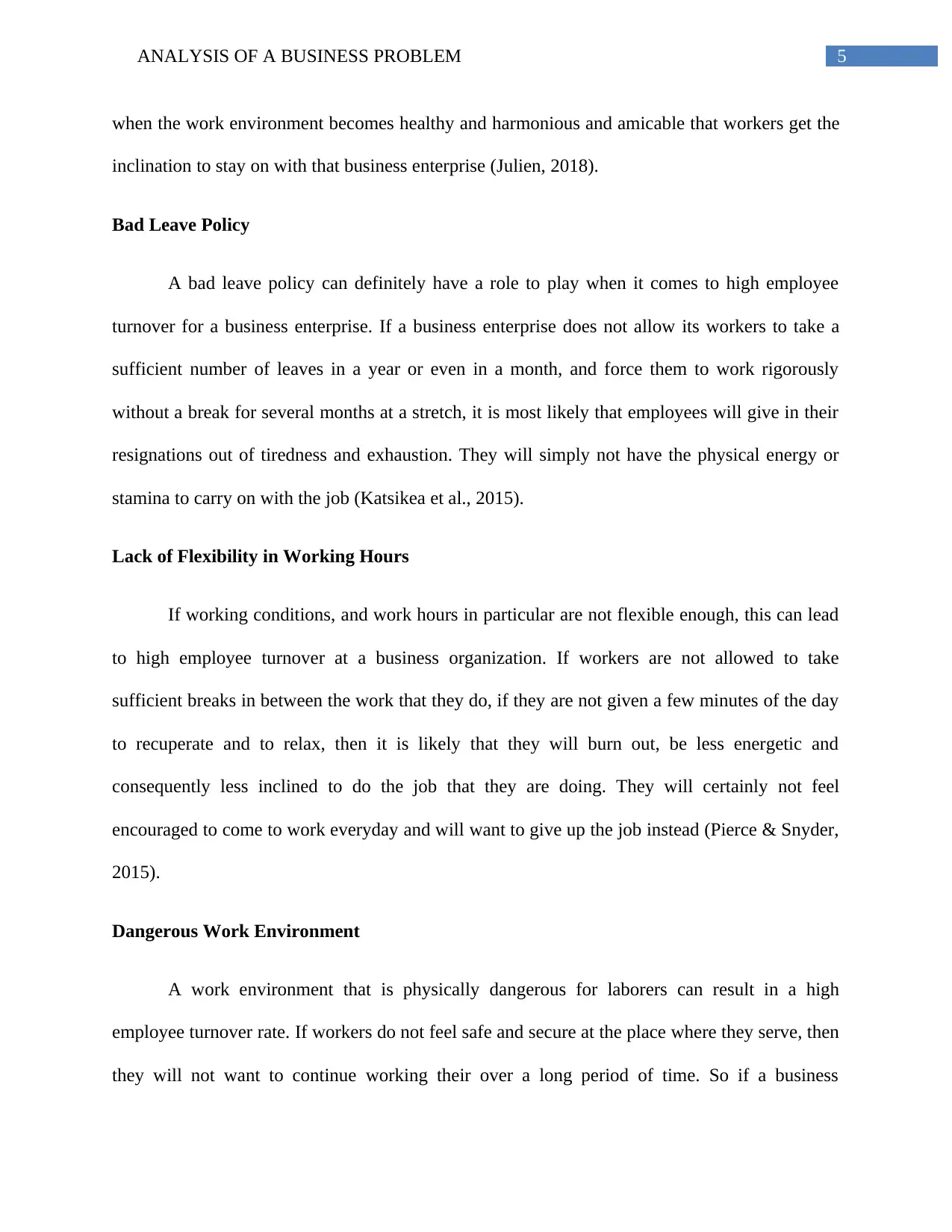
5ANALYSIS OF A BUSINESS PROBLEM
when the work environment becomes healthy and harmonious and amicable that workers get the
inclination to stay on with that business enterprise (Julien, 2018).
Bad Leave Policy
A bad leave policy can definitely have a role to play when it comes to high employee
turnover for a business enterprise. If a business enterprise does not allow its workers to take a
sufficient number of leaves in a year or even in a month, and force them to work rigorously
without a break for several months at a stretch, it is most likely that employees will give in their
resignations out of tiredness and exhaustion. They will simply not have the physical energy or
stamina to carry on with the job (Katsikea et al., 2015).
Lack of Flexibility in Working Hours
If working conditions, and work hours in particular are not flexible enough, this can lead
to high employee turnover at a business organization. If workers are not allowed to take
sufficient breaks in between the work that they do, if they are not given a few minutes of the day
to recuperate and to relax, then it is likely that they will burn out, be less energetic and
consequently less inclined to do the job that they are doing. They will certainly not feel
encouraged to come to work everyday and will want to give up the job instead (Pierce & Snyder,
2015).
Dangerous Work Environment
A work environment that is physically dangerous for laborers can result in a high
employee turnover rate. If workers do not feel safe and secure at the place where they serve, then
they will not want to continue working their over a long period of time. So if a business
when the work environment becomes healthy and harmonious and amicable that workers get the
inclination to stay on with that business enterprise (Julien, 2018).
Bad Leave Policy
A bad leave policy can definitely have a role to play when it comes to high employee
turnover for a business enterprise. If a business enterprise does not allow its workers to take a
sufficient number of leaves in a year or even in a month, and force them to work rigorously
without a break for several months at a stretch, it is most likely that employees will give in their
resignations out of tiredness and exhaustion. They will simply not have the physical energy or
stamina to carry on with the job (Katsikea et al., 2015).
Lack of Flexibility in Working Hours
If working conditions, and work hours in particular are not flexible enough, this can lead
to high employee turnover at a business organization. If workers are not allowed to take
sufficient breaks in between the work that they do, if they are not given a few minutes of the day
to recuperate and to relax, then it is likely that they will burn out, be less energetic and
consequently less inclined to do the job that they are doing. They will certainly not feel
encouraged to come to work everyday and will want to give up the job instead (Pierce & Snyder,
2015).
Dangerous Work Environment
A work environment that is physically dangerous for laborers can result in a high
employee turnover rate. If workers do not feel safe and secure at the place where they serve, then
they will not want to continue working their over a long period of time. So if a business
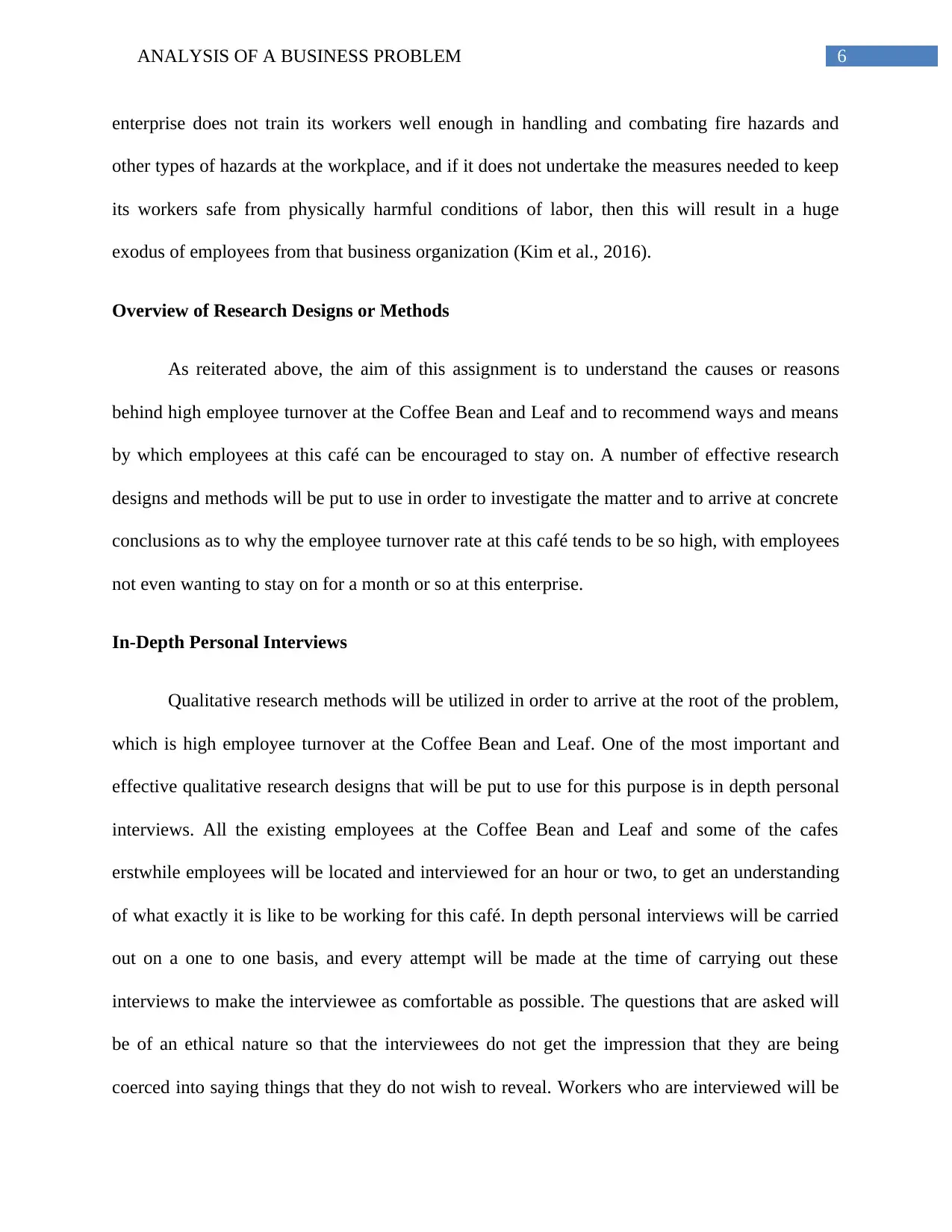
6ANALYSIS OF A BUSINESS PROBLEM
enterprise does not train its workers well enough in handling and combating fire hazards and
other types of hazards at the workplace, and if it does not undertake the measures needed to keep
its workers safe from physically harmful conditions of labor, then this will result in a huge
exodus of employees from that business organization (Kim et al., 2016).
Overview of Research Designs or Methods
As reiterated above, the aim of this assignment is to understand the causes or reasons
behind high employee turnover at the Coffee Bean and Leaf and to recommend ways and means
by which employees at this café can be encouraged to stay on. A number of effective research
designs and methods will be put to use in order to investigate the matter and to arrive at concrete
conclusions as to why the employee turnover rate at this café tends to be so high, with employees
not even wanting to stay on for a month or so at this enterprise.
In-Depth Personal Interviews
Qualitative research methods will be utilized in order to arrive at the root of the problem,
which is high employee turnover at the Coffee Bean and Leaf. One of the most important and
effective qualitative research designs that will be put to use for this purpose is in depth personal
interviews. All the existing employees at the Coffee Bean and Leaf and some of the cafes
erstwhile employees will be located and interviewed for an hour or two, to get an understanding
of what exactly it is like to be working for this café. In depth personal interviews will be carried
out on a one to one basis, and every attempt will be made at the time of carrying out these
interviews to make the interviewee as comfortable as possible. The questions that are asked will
be of an ethical nature so that the interviewees do not get the impression that they are being
coerced into saying things that they do not wish to reveal. Workers who are interviewed will be
enterprise does not train its workers well enough in handling and combating fire hazards and
other types of hazards at the workplace, and if it does not undertake the measures needed to keep
its workers safe from physically harmful conditions of labor, then this will result in a huge
exodus of employees from that business organization (Kim et al., 2016).
Overview of Research Designs or Methods
As reiterated above, the aim of this assignment is to understand the causes or reasons
behind high employee turnover at the Coffee Bean and Leaf and to recommend ways and means
by which employees at this café can be encouraged to stay on. A number of effective research
designs and methods will be put to use in order to investigate the matter and to arrive at concrete
conclusions as to why the employee turnover rate at this café tends to be so high, with employees
not even wanting to stay on for a month or so at this enterprise.
In-Depth Personal Interviews
Qualitative research methods will be utilized in order to arrive at the root of the problem,
which is high employee turnover at the Coffee Bean and Leaf. One of the most important and
effective qualitative research designs that will be put to use for this purpose is in depth personal
interviews. All the existing employees at the Coffee Bean and Leaf and some of the cafes
erstwhile employees will be located and interviewed for an hour or two, to get an understanding
of what exactly it is like to be working for this café. In depth personal interviews will be carried
out on a one to one basis, and every attempt will be made at the time of carrying out these
interviews to make the interviewee as comfortable as possible. The questions that are asked will
be of an ethical nature so that the interviewees do not get the impression that they are being
coerced into saying things that they do not wish to reveal. Workers who are interviewed will be
Paraphrase This Document
Need a fresh take? Get an instant paraphrase of this document with our AI Paraphraser
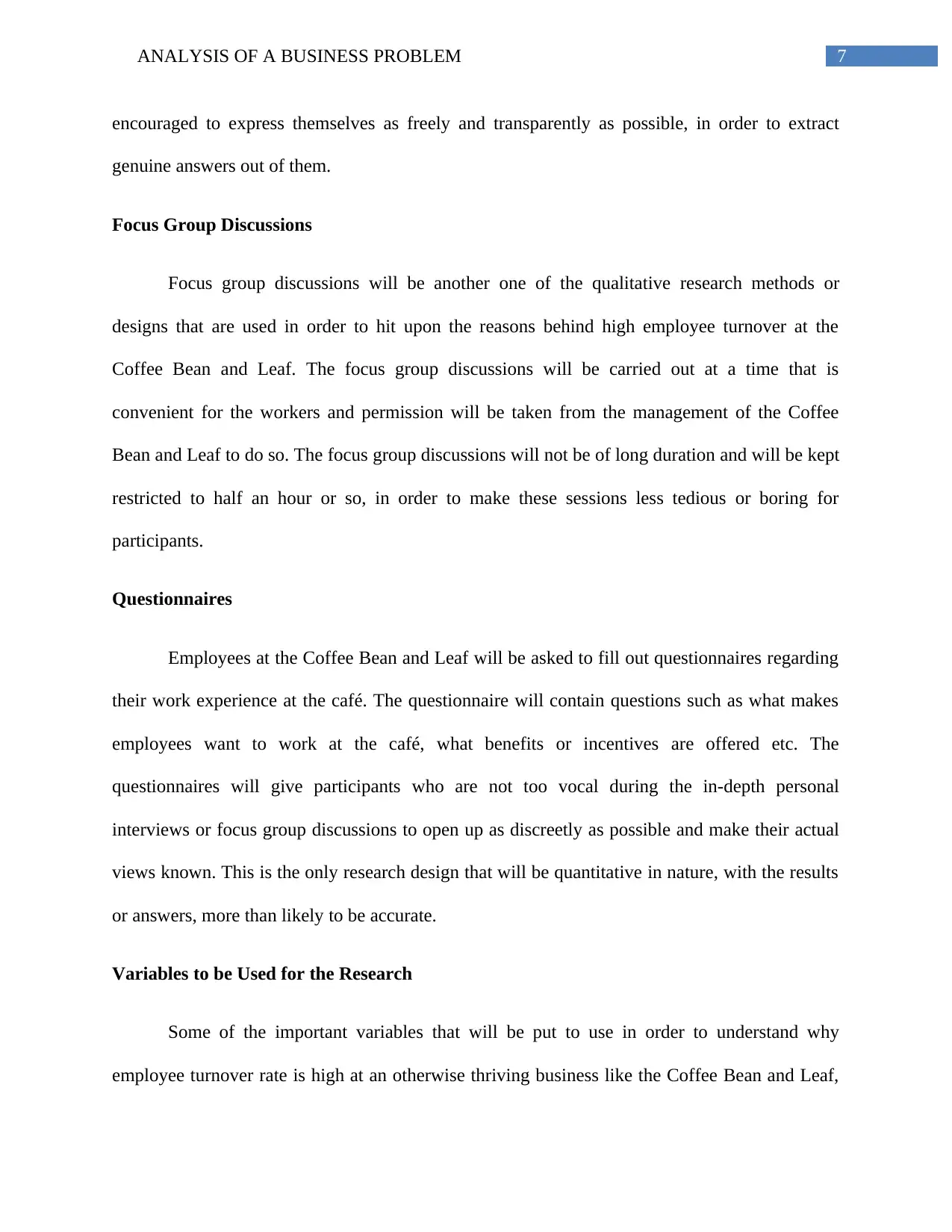
7ANALYSIS OF A BUSINESS PROBLEM
encouraged to express themselves as freely and transparently as possible, in order to extract
genuine answers out of them.
Focus Group Discussions
Focus group discussions will be another one of the qualitative research methods or
designs that are used in order to hit upon the reasons behind high employee turnover at the
Coffee Bean and Leaf. The focus group discussions will be carried out at a time that is
convenient for the workers and permission will be taken from the management of the Coffee
Bean and Leaf to do so. The focus group discussions will not be of long duration and will be kept
restricted to half an hour or so, in order to make these sessions less tedious or boring for
participants.
Questionnaires
Employees at the Coffee Bean and Leaf will be asked to fill out questionnaires regarding
their work experience at the café. The questionnaire will contain questions such as what makes
employees want to work at the café, what benefits or incentives are offered etc. The
questionnaires will give participants who are not too vocal during the in-depth personal
interviews or focus group discussions to open up as discreetly as possible and make their actual
views known. This is the only research design that will be quantitative in nature, with the results
or answers, more than likely to be accurate.
Variables to be Used for the Research
Some of the important variables that will be put to use in order to understand why
employee turnover rate is high at an otherwise thriving business like the Coffee Bean and Leaf,
encouraged to express themselves as freely and transparently as possible, in order to extract
genuine answers out of them.
Focus Group Discussions
Focus group discussions will be another one of the qualitative research methods or
designs that are used in order to hit upon the reasons behind high employee turnover at the
Coffee Bean and Leaf. The focus group discussions will be carried out at a time that is
convenient for the workers and permission will be taken from the management of the Coffee
Bean and Leaf to do so. The focus group discussions will not be of long duration and will be kept
restricted to half an hour or so, in order to make these sessions less tedious or boring for
participants.
Questionnaires
Employees at the Coffee Bean and Leaf will be asked to fill out questionnaires regarding
their work experience at the café. The questionnaire will contain questions such as what makes
employees want to work at the café, what benefits or incentives are offered etc. The
questionnaires will give participants who are not too vocal during the in-depth personal
interviews or focus group discussions to open up as discreetly as possible and make their actual
views known. This is the only research design that will be quantitative in nature, with the results
or answers, more than likely to be accurate.
Variables to be Used for the Research
Some of the important variables that will be put to use in order to understand why
employee turnover rate is high at an otherwise thriving business like the Coffee Bean and Leaf,
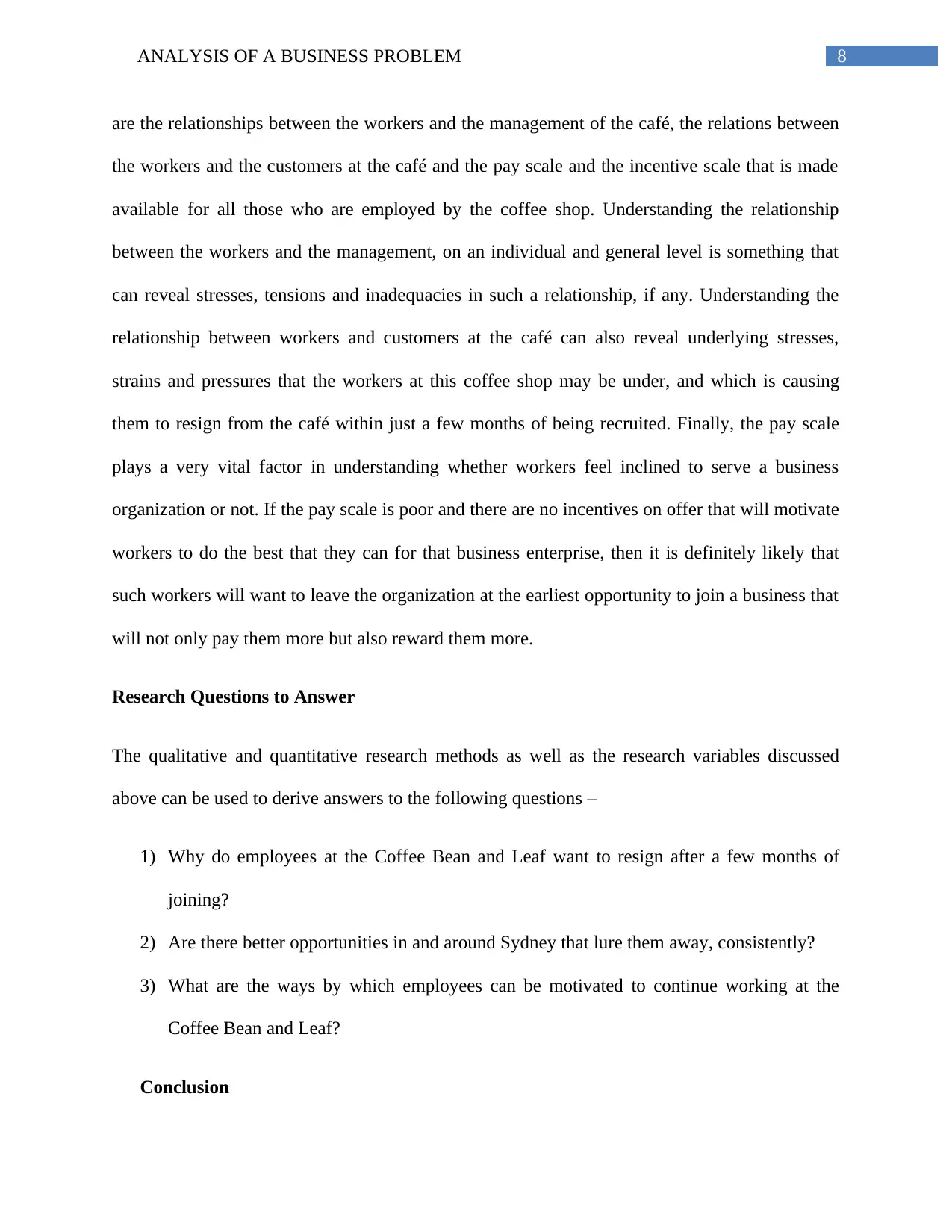
8ANALYSIS OF A BUSINESS PROBLEM
are the relationships between the workers and the management of the café, the relations between
the workers and the customers at the café and the pay scale and the incentive scale that is made
available for all those who are employed by the coffee shop. Understanding the relationship
between the workers and the management, on an individual and general level is something that
can reveal stresses, tensions and inadequacies in such a relationship, if any. Understanding the
relationship between workers and customers at the café can also reveal underlying stresses,
strains and pressures that the workers at this coffee shop may be under, and which is causing
them to resign from the café within just a few months of being recruited. Finally, the pay scale
plays a very vital factor in understanding whether workers feel inclined to serve a business
organization or not. If the pay scale is poor and there are no incentives on offer that will motivate
workers to do the best that they can for that business enterprise, then it is definitely likely that
such workers will want to leave the organization at the earliest opportunity to join a business that
will not only pay them more but also reward them more.
Research Questions to Answer
The qualitative and quantitative research methods as well as the research variables discussed
above can be used to derive answers to the following questions –
1) Why do employees at the Coffee Bean and Leaf want to resign after a few months of
joining?
2) Are there better opportunities in and around Sydney that lure them away, consistently?
3) What are the ways by which employees can be motivated to continue working at the
Coffee Bean and Leaf?
Conclusion
are the relationships between the workers and the management of the café, the relations between
the workers and the customers at the café and the pay scale and the incentive scale that is made
available for all those who are employed by the coffee shop. Understanding the relationship
between the workers and the management, on an individual and general level is something that
can reveal stresses, tensions and inadequacies in such a relationship, if any. Understanding the
relationship between workers and customers at the café can also reveal underlying stresses,
strains and pressures that the workers at this coffee shop may be under, and which is causing
them to resign from the café within just a few months of being recruited. Finally, the pay scale
plays a very vital factor in understanding whether workers feel inclined to serve a business
organization or not. If the pay scale is poor and there are no incentives on offer that will motivate
workers to do the best that they can for that business enterprise, then it is definitely likely that
such workers will want to leave the organization at the earliest opportunity to join a business that
will not only pay them more but also reward them more.
Research Questions to Answer
The qualitative and quantitative research methods as well as the research variables discussed
above can be used to derive answers to the following questions –
1) Why do employees at the Coffee Bean and Leaf want to resign after a few months of
joining?
2) Are there better opportunities in and around Sydney that lure them away, consistently?
3) What are the ways by which employees can be motivated to continue working at the
Coffee Bean and Leaf?
Conclusion
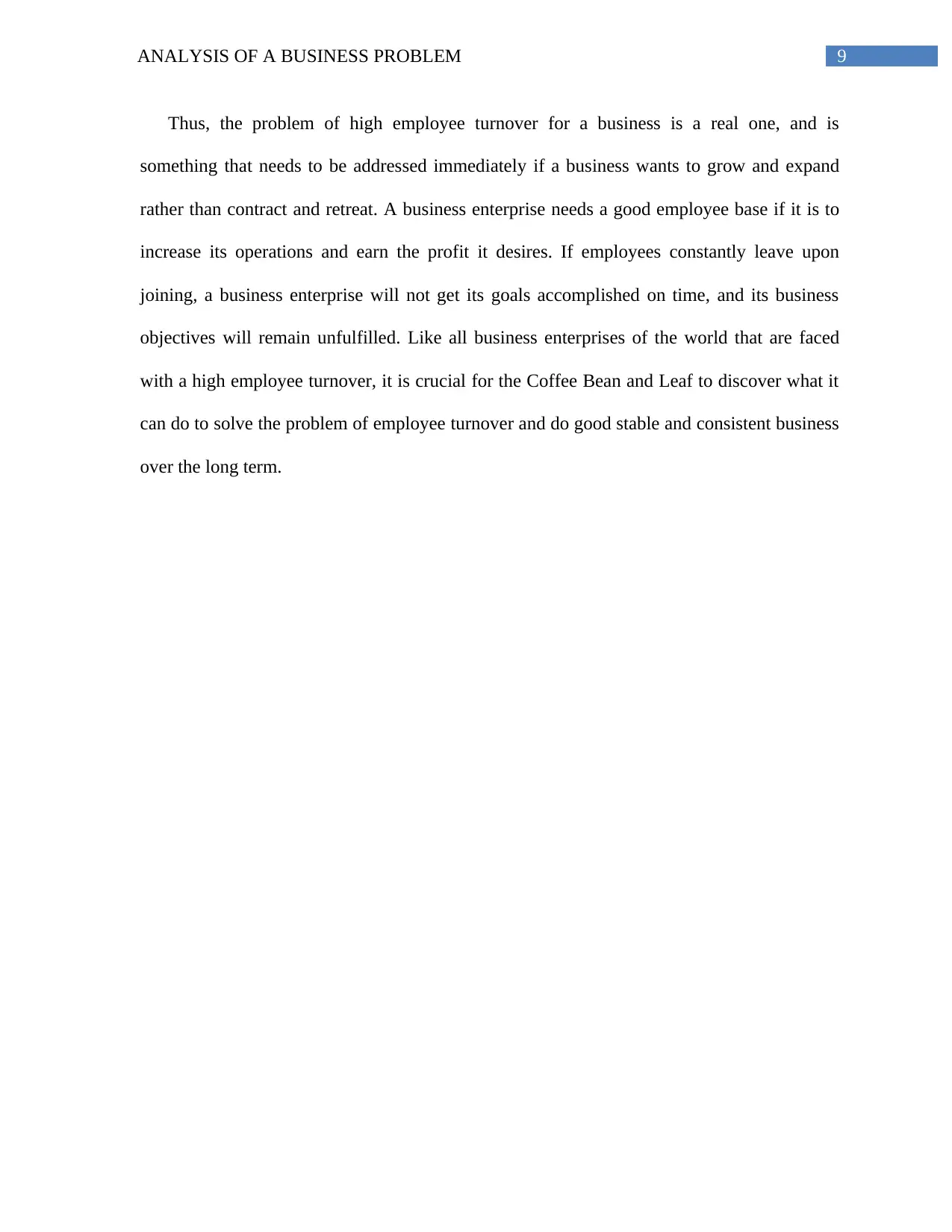
9ANALYSIS OF A BUSINESS PROBLEM
Thus, the problem of high employee turnover for a business is a real one, and is
something that needs to be addressed immediately if a business wants to grow and expand
rather than contract and retreat. A business enterprise needs a good employee base if it is to
increase its operations and earn the profit it desires. If employees constantly leave upon
joining, a business enterprise will not get its goals accomplished on time, and its business
objectives will remain unfulfilled. Like all business enterprises of the world that are faced
with a high employee turnover, it is crucial for the Coffee Bean and Leaf to discover what it
can do to solve the problem of employee turnover and do good stable and consistent business
over the long term.
Thus, the problem of high employee turnover for a business is a real one, and is
something that needs to be addressed immediately if a business wants to grow and expand
rather than contract and retreat. A business enterprise needs a good employee base if it is to
increase its operations and earn the profit it desires. If employees constantly leave upon
joining, a business enterprise will not get its goals accomplished on time, and its business
objectives will remain unfulfilled. Like all business enterprises of the world that are faced
with a high employee turnover, it is crucial for the Coffee Bean and Leaf to discover what it
can do to solve the problem of employee turnover and do good stable and consistent business
over the long term.
Secure Best Marks with AI Grader
Need help grading? Try our AI Grader for instant feedback on your assignments.
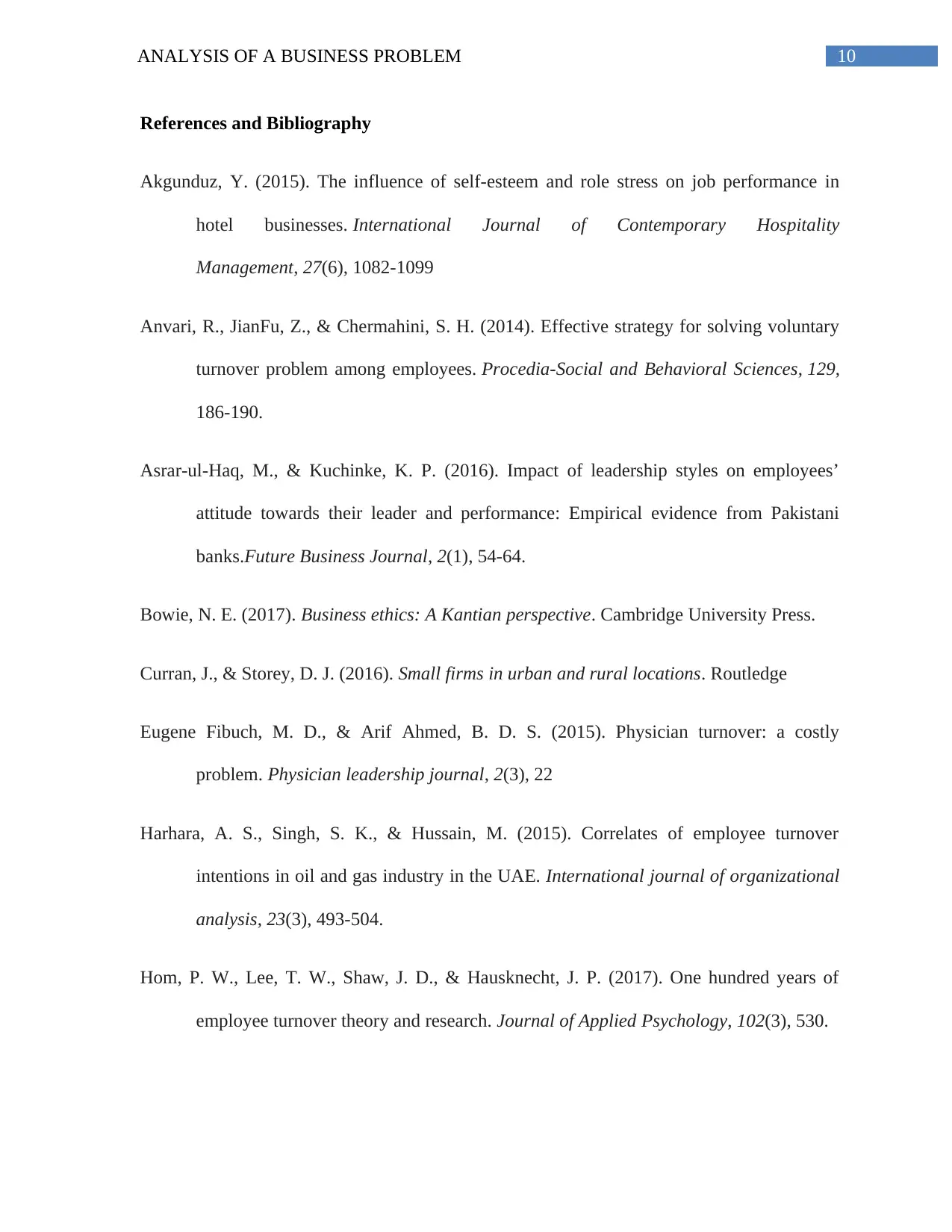
10ANALYSIS OF A BUSINESS PROBLEM
References and Bibliography
Akgunduz, Y. (2015). The influence of self-esteem and role stress on job performance in
hotel businesses. International Journal of Contemporary Hospitality
Management, 27(6), 1082-1099
Anvari, R., JianFu, Z., & Chermahini, S. H. (2014). Effective strategy for solving voluntary
turnover problem among employees. Procedia-Social and Behavioral Sciences, 129,
186-190.
Asrar-ul-Haq, M., & Kuchinke, K. P. (2016). Impact of leadership styles on employees’
attitude towards their leader and performance: Empirical evidence from Pakistani
banks.Future Business Journal, 2(1), 54-64.
Bowie, N. E. (2017). Business ethics: A Kantian perspective. Cambridge University Press.
Curran, J., & Storey, D. J. (2016). Small firms in urban and rural locations. Routledge
Eugene Fibuch, M. D., & Arif Ahmed, B. D. S. (2015). Physician turnover: a costly
problem. Physician leadership journal, 2(3), 22
Harhara, A. S., Singh, S. K., & Hussain, M. (2015). Correlates of employee turnover
intentions in oil and gas industry in the UAE. International journal of organizational
analysis, 23(3), 493-504.
Hom, P. W., Lee, T. W., Shaw, J. D., & Hausknecht, J. P. (2017). One hundred years of
employee turnover theory and research. Journal of Applied Psychology, 102(3), 530.
References and Bibliography
Akgunduz, Y. (2015). The influence of self-esteem and role stress on job performance in
hotel businesses. International Journal of Contemporary Hospitality
Management, 27(6), 1082-1099
Anvari, R., JianFu, Z., & Chermahini, S. H. (2014). Effective strategy for solving voluntary
turnover problem among employees. Procedia-Social and Behavioral Sciences, 129,
186-190.
Asrar-ul-Haq, M., & Kuchinke, K. P. (2016). Impact of leadership styles on employees’
attitude towards their leader and performance: Empirical evidence from Pakistani
banks.Future Business Journal, 2(1), 54-64.
Bowie, N. E. (2017). Business ethics: A Kantian perspective. Cambridge University Press.
Curran, J., & Storey, D. J. (2016). Small firms in urban and rural locations. Routledge
Eugene Fibuch, M. D., & Arif Ahmed, B. D. S. (2015). Physician turnover: a costly
problem. Physician leadership journal, 2(3), 22
Harhara, A. S., Singh, S. K., & Hussain, M. (2015). Correlates of employee turnover
intentions in oil and gas industry in the UAE. International journal of organizational
analysis, 23(3), 493-504.
Hom, P. W., Lee, T. W., Shaw, J. D., & Hausknecht, J. P. (2017). One hundred years of
employee turnover theory and research. Journal of Applied Psychology, 102(3), 530.
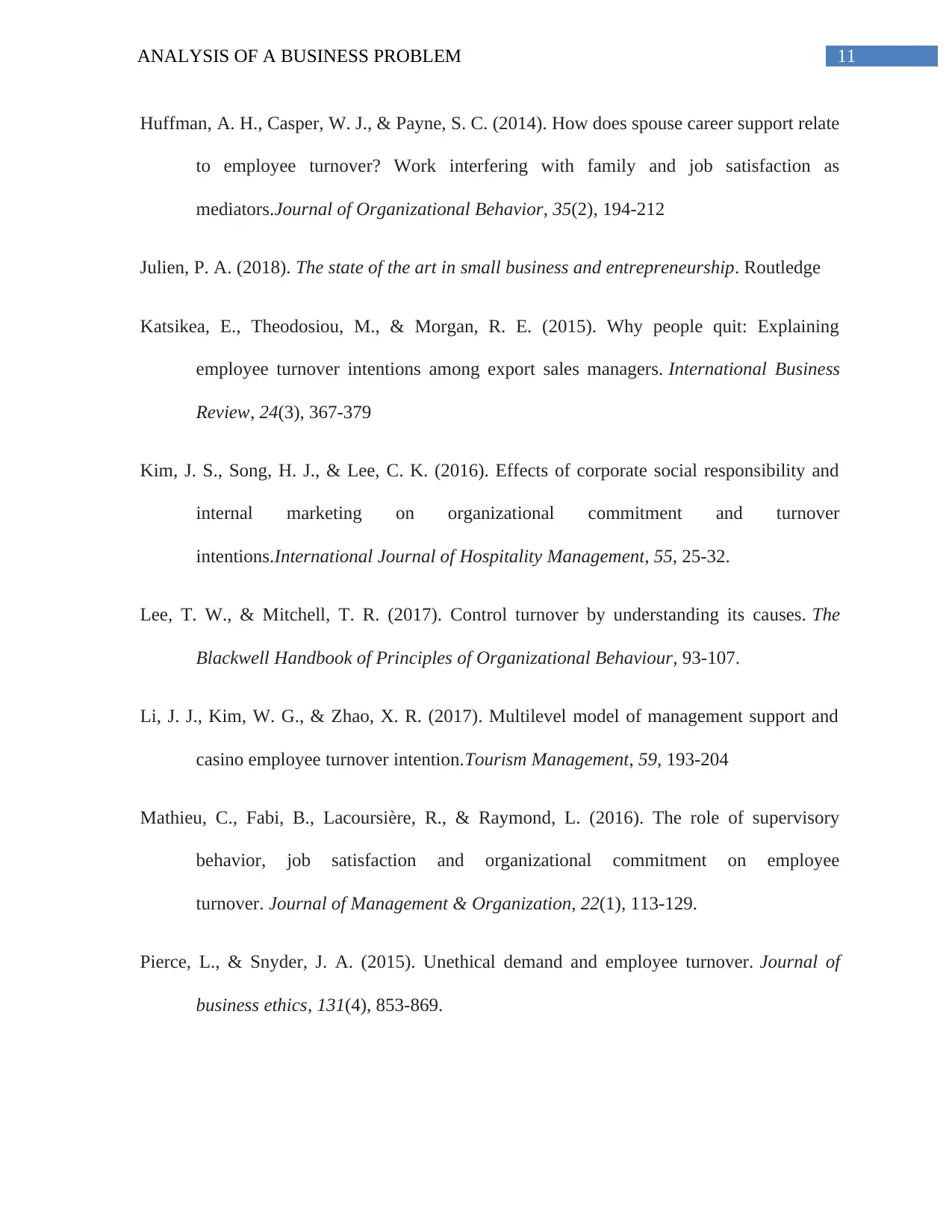
11ANALYSIS OF A BUSINESS PROBLEM
Huffman, A. H., Casper, W. J., & Payne, S. C. (2014). How does spouse career support relate
to employee turnover? Work interfering with family and job satisfaction as
mediators.Journal of Organizational Behavior, 35(2), 194-212
Julien, P. A. (2018). The state of the art in small business and entrepreneurship. Routledge
Katsikea, E., Theodosiou, M., & Morgan, R. E. (2015). Why people quit: Explaining
employee turnover intentions among export sales managers. International Business
Review, 24(3), 367-379
Kim, J. S., Song, H. J., & Lee, C. K. (2016). Effects of corporate social responsibility and
internal marketing on organizational commitment and turnover
intentions.International Journal of Hospitality Management, 55, 25-32.
Lee, T. W., & Mitchell, T. R. (2017). Control turnover by understanding its causes. The
Blackwell Handbook of Principles of Organizational Behaviour, 93-107.
Li, J. J., Kim, W. G., & Zhao, X. R. (2017). Multilevel model of management support and
casino employee turnover intention.Tourism Management, 59, 193-204
Mathieu, C., Fabi, B., Lacoursière, R., & Raymond, L. (2016). The role of supervisory
behavior, job satisfaction and organizational commitment on employee
turnover. Journal of Management & Organization, 22(1), 113-129.
Pierce, L., & Snyder, J. A. (2015). Unethical demand and employee turnover. Journal of
business ethics, 131(4), 853-869.
Huffman, A. H., Casper, W. J., & Payne, S. C. (2014). How does spouse career support relate
to employee turnover? Work interfering with family and job satisfaction as
mediators.Journal of Organizational Behavior, 35(2), 194-212
Julien, P. A. (2018). The state of the art in small business and entrepreneurship. Routledge
Katsikea, E., Theodosiou, M., & Morgan, R. E. (2015). Why people quit: Explaining
employee turnover intentions among export sales managers. International Business
Review, 24(3), 367-379
Kim, J. S., Song, H. J., & Lee, C. K. (2016). Effects of corporate social responsibility and
internal marketing on organizational commitment and turnover
intentions.International Journal of Hospitality Management, 55, 25-32.
Lee, T. W., & Mitchell, T. R. (2017). Control turnover by understanding its causes. The
Blackwell Handbook of Principles of Organizational Behaviour, 93-107.
Li, J. J., Kim, W. G., & Zhao, X. R. (2017). Multilevel model of management support and
casino employee turnover intention.Tourism Management, 59, 193-204
Mathieu, C., Fabi, B., Lacoursière, R., & Raymond, L. (2016). The role of supervisory
behavior, job satisfaction and organizational commitment on employee
turnover. Journal of Management & Organization, 22(1), 113-129.
Pierce, L., & Snyder, J. A. (2015). Unethical demand and employee turnover. Journal of
business ethics, 131(4), 853-869.

12ANALYSIS OF A BUSINESS PROBLEM
Pohler, D., & Schmidt, J. A. (2016). Does Pay‐for‐Performance Strain the Employment
Relationship? The Effect of Manager Bonus Eligibility on Nonmanagement
Employee Turnover.Personnel Psychology, 69(2), 395-429
Raina, R., & Roebuck, D. B. (2016). Exploring cultural influence on managerial
communication in relationship to job satisfaction, organizational commitment, and
the employees’ propensity to leave in the insurance sector of India.International
Journal of Business Communication, 53(1), 97-130.
Revilla-Camacho, M. Á., Vega-Vázquez, M., & Cossío-Silva, F. J. (2015). Customer
participation and citizenship behavior effects on turnover intention. Journal of
business research,68(7), 1607-1611
Selden, S. C., & Sowa, J. E. (2015). Voluntary turnover in nonprofit human service
organizations: The impact of high performance work practices. Human Service
Organizations: Management, Leadership & Governance, 39(3), 182-207.
Storey, D. J. (2016). Understanding the small business sector. Routledge
Zhang, Y. (2016). A review of employee turnover influence factor and
countermeasure. Journal of Human Resource and Sustainability Studies, 4(02), 85.
Pohler, D., & Schmidt, J. A. (2016). Does Pay‐for‐Performance Strain the Employment
Relationship? The Effect of Manager Bonus Eligibility on Nonmanagement
Employee Turnover.Personnel Psychology, 69(2), 395-429
Raina, R., & Roebuck, D. B. (2016). Exploring cultural influence on managerial
communication in relationship to job satisfaction, organizational commitment, and
the employees’ propensity to leave in the insurance sector of India.International
Journal of Business Communication, 53(1), 97-130.
Revilla-Camacho, M. Á., Vega-Vázquez, M., & Cossío-Silva, F. J. (2015). Customer
participation and citizenship behavior effects on turnover intention. Journal of
business research,68(7), 1607-1611
Selden, S. C., & Sowa, J. E. (2015). Voluntary turnover in nonprofit human service
organizations: The impact of high performance work practices. Human Service
Organizations: Management, Leadership & Governance, 39(3), 182-207.
Storey, D. J. (2016). Understanding the small business sector. Routledge
Zhang, Y. (2016). A review of employee turnover influence factor and
countermeasure. Journal of Human Resource and Sustainability Studies, 4(02), 85.
1 out of 13
Your All-in-One AI-Powered Toolkit for Academic Success.
+13062052269
info@desklib.com
Available 24*7 on WhatsApp / Email
![[object Object]](/_next/static/media/star-bottom.7253800d.svg)
Unlock your academic potential
© 2024 | Zucol Services PVT LTD | All rights reserved.

